Corporate Financial Management: Analysis and Practical Application
VerifiedAdded on 2023/06/18
|12
|2291
|109
Report
AI Summary
This report provides an overview of corporate financing in practice, focusing on the significance of financial administration within a company. It elaborates on key aspects such as managing personal money, utilizing metrics in fiscal planning, and summarizing income reports. The report assesses the importance of financial management in handling operating costs, forecasting finances, protecting funds, distributing funds effectively, and increasing prosperity. It discusses the use of financial reports, including balance sheets, income statements, and cash flow statements, in evaluating a company's financial condition. Additionally, the role of ratios in assessing a company's financial health, operating efficiency, and liquidity position is examined. The analysis concludes that a company's efficiency in generating income is strong, but improvements in net revenue percentage are needed through cost reduction.

Business
Paraphrase This Document
Need a fresh take? Get an instant paraphrase of this document with our AI Paraphraser
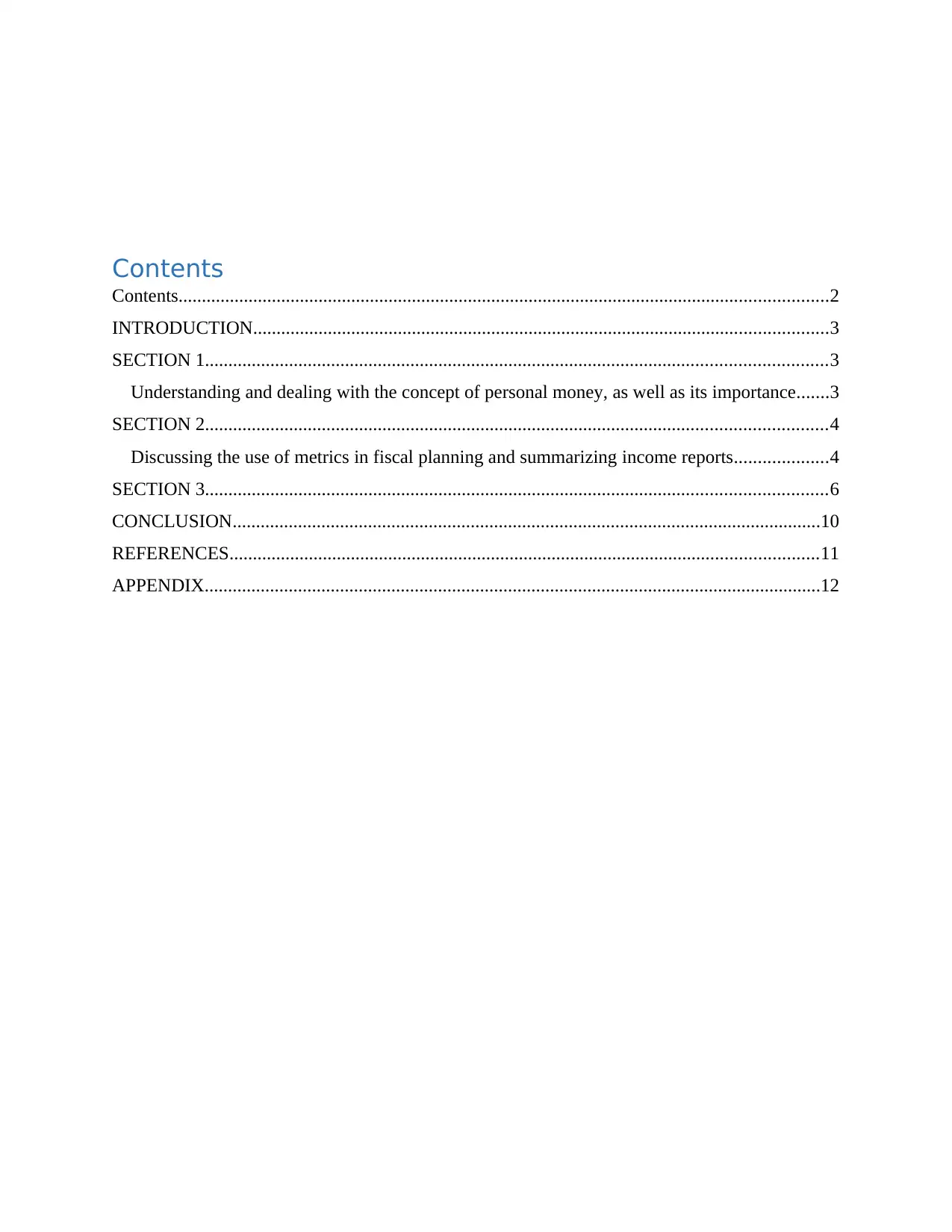
Contents
Contents...........................................................................................................................................2
INTRODUCTION...........................................................................................................................3
SECTION 1.....................................................................................................................................3
Understanding and dealing with the concept of personal money, as well as its importance.......3
SECTION 2.....................................................................................................................................4
Discussing the use of metrics in fiscal planning and summarizing income reports....................4
SECTION 3.....................................................................................................................................6
CONCLUSION..............................................................................................................................10
REFERENCES..............................................................................................................................11
APPENDIX....................................................................................................................................12
Contents...........................................................................................................................................2
INTRODUCTION...........................................................................................................................3
SECTION 1.....................................................................................................................................3
Understanding and dealing with the concept of personal money, as well as its importance.......3
SECTION 2.....................................................................................................................................4
Discussing the use of metrics in fiscal planning and summarizing income reports....................4
SECTION 3.....................................................................................................................................6
CONCLUSION..............................................................................................................................10
REFERENCES..............................................................................................................................11
APPENDIX....................................................................................................................................12
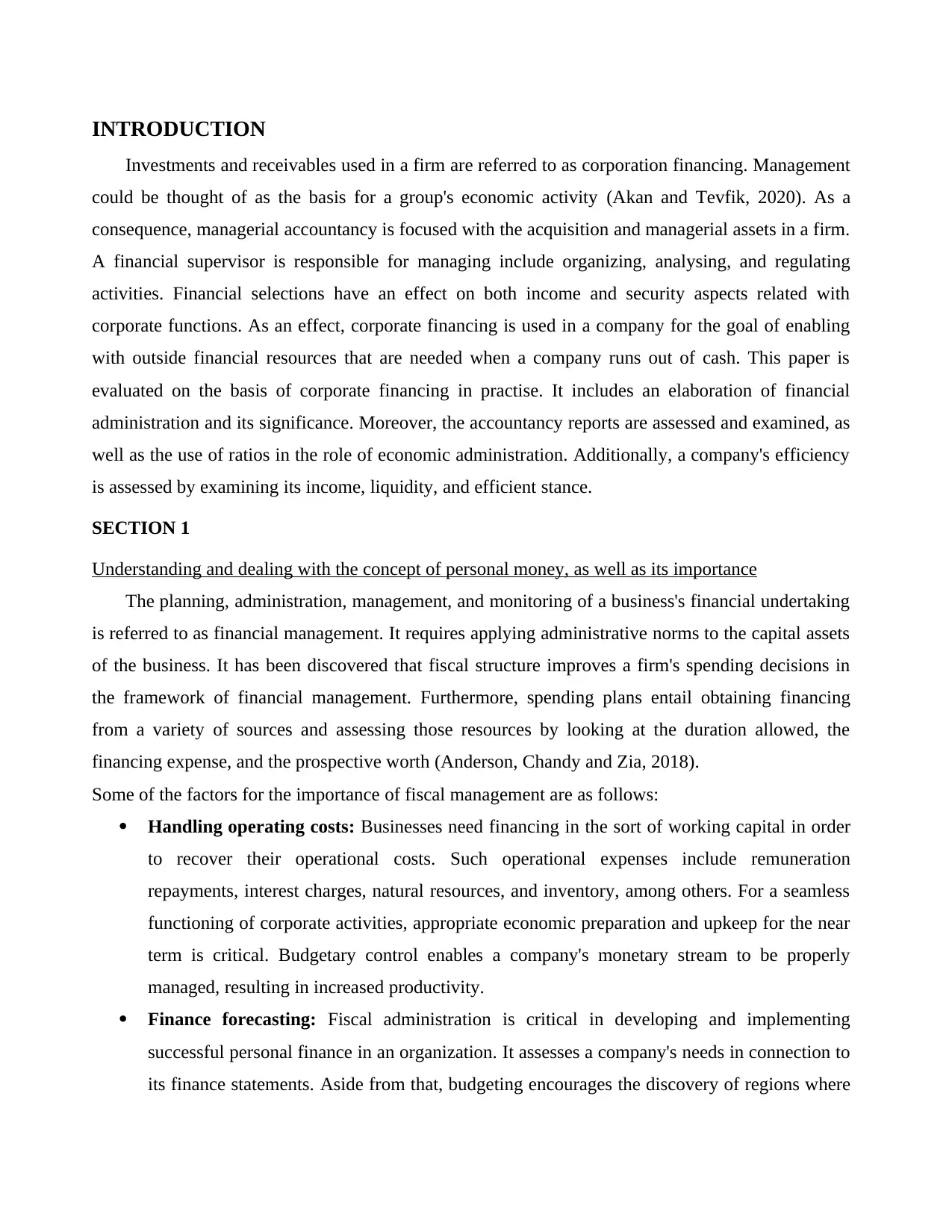
INTRODUCTION
Investments and receivables used in a firm are referred to as corporation financing. Management
could be thought of as the basis for a group's economic activity (Akan and Tevfik, 2020). As a
consequence, managerial accountancy is focused with the acquisition and managerial assets in a firm.
A financial supervisor is responsible for managing include organizing, analysing, and regulating
activities. Financial selections have an effect on both income and security aspects related with
corporate functions. As an effect, corporate financing is used in a company for the goal of enabling
with outside financial resources that are needed when a company runs out of cash. This paper is
evaluated on the basis of corporate financing in practise. It includes an elaboration of financial
administration and its significance. Moreover, the accountancy reports are assessed and examined, as
well as the use of ratios in the role of economic administration. Additionally, a company's efficiency
is assessed by examining its income, liquidity, and efficient stance.
SECTION 1
Understanding and dealing with the concept of personal money, as well as its importance
The planning, administration, management, and monitoring of a business's financial undertaking
is referred to as financial management. It requires applying administrative norms to the capital assets
of the business. It has been discovered that fiscal structure improves a firm's spending decisions in
the framework of financial management. Furthermore, spending plans entail obtaining financing
from a variety of sources and assessing those resources by looking at the duration allowed, the
financing expense, and the prospective worth (Anderson, Chandy and Zia, 2018).
Some of the factors for the importance of fiscal management are as follows:
Handling operating costs: Businesses need financing in the sort of working capital in order
to recover their operational costs. Such operational expenses include remuneration
repayments, interest charges, natural resources, and inventory, among others. For a seamless
functioning of corporate activities, appropriate economic preparation and upkeep for the near
term is critical. Budgetary control enables a company's monetary stream to be properly
managed, resulting in increased productivity.
Finance forecasting: Fiscal administration is critical in developing and implementing
successful personal finance in an organization. It assesses a company's needs in connection to
its finance statements. Aside from that, budgeting encourages the discovery of regions where
Investments and receivables used in a firm are referred to as corporation financing. Management
could be thought of as the basis for a group's economic activity (Akan and Tevfik, 2020). As a
consequence, managerial accountancy is focused with the acquisition and managerial assets in a firm.
A financial supervisor is responsible for managing include organizing, analysing, and regulating
activities. Financial selections have an effect on both income and security aspects related with
corporate functions. As an effect, corporate financing is used in a company for the goal of enabling
with outside financial resources that are needed when a company runs out of cash. This paper is
evaluated on the basis of corporate financing in practise. It includes an elaboration of financial
administration and its significance. Moreover, the accountancy reports are assessed and examined, as
well as the use of ratios in the role of economic administration. Additionally, a company's efficiency
is assessed by examining its income, liquidity, and efficient stance.
SECTION 1
Understanding and dealing with the concept of personal money, as well as its importance
The planning, administration, management, and monitoring of a business's financial undertaking
is referred to as financial management. It requires applying administrative norms to the capital assets
of the business. It has been discovered that fiscal structure improves a firm's spending decisions in
the framework of financial management. Furthermore, spending plans entail obtaining financing
from a variety of sources and assessing those resources by looking at the duration allowed, the
financing expense, and the prospective worth (Anderson, Chandy and Zia, 2018).
Some of the factors for the importance of fiscal management are as follows:
Handling operating costs: Businesses need financing in the sort of working capital in order
to recover their operational costs. Such operational expenses include remuneration
repayments, interest charges, natural resources, and inventory, among others. For a seamless
functioning of corporate activities, appropriate economic preparation and upkeep for the near
term is critical. Budgetary control enables a company's monetary stream to be properly
managed, resulting in increased productivity.
Finance forecasting: Fiscal administration is critical in developing and implementing
successful personal finance in an organization. It assesses a company's needs in connection to
its finance statements. Aside from that, budgeting encourages the discovery of regions where
⊘ This is a preview!⊘
Do you want full access?
Subscribe today to unlock all pages.

Trusted by 1+ million students worldwide
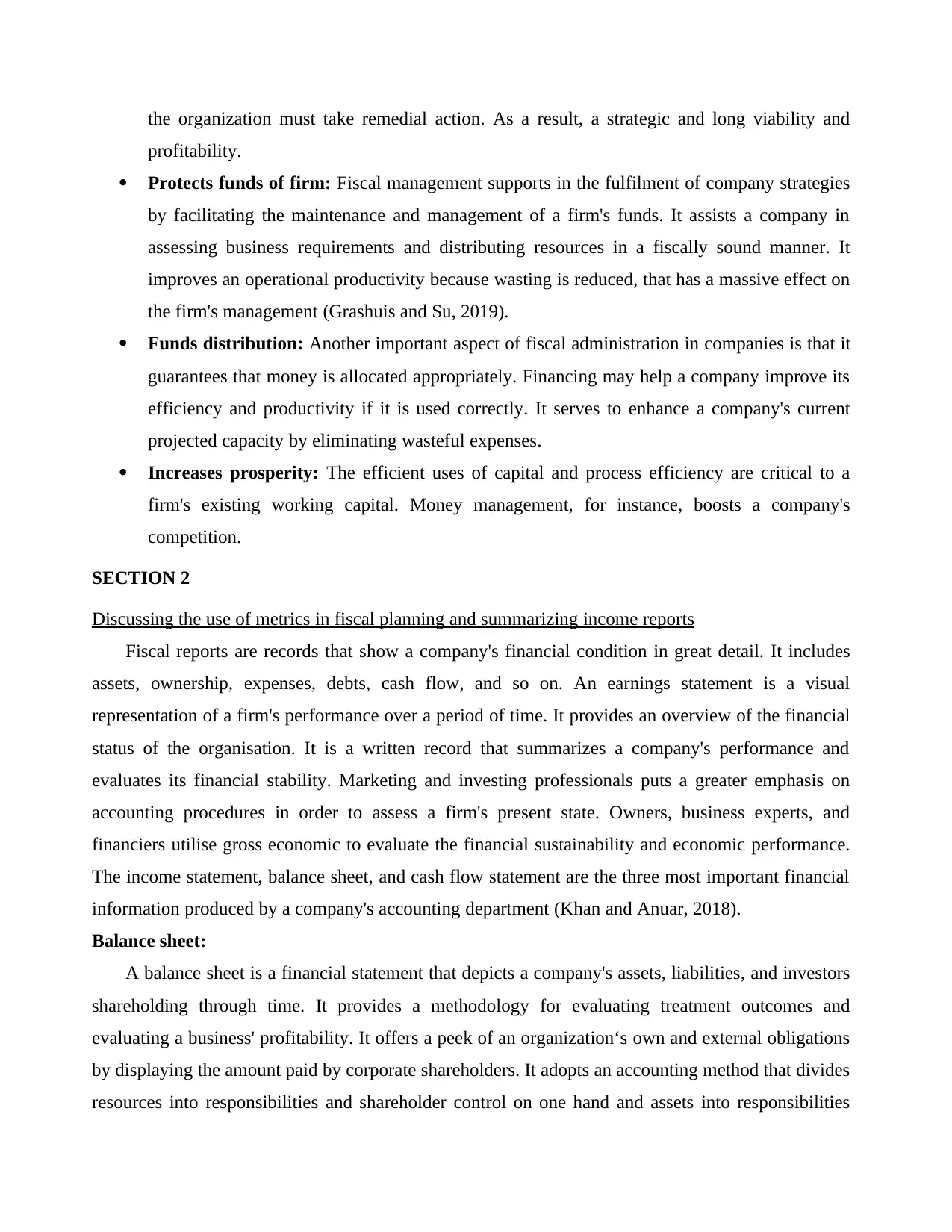
the organization must take remedial action. As a result, a strategic and long viability and
profitability.
Protects funds of firm: Fiscal management supports in the fulfilment of company strategies
by facilitating the maintenance and management of a firm's funds. It assists a company in
assessing business requirements and distributing resources in a fiscally sound manner. It
improves an operational productivity because wasting is reduced, that has a massive effect on
the firm's management (Grashuis and Su, 2019).
Funds distribution: Another important aspect of fiscal administration in companies is that it
guarantees that money is allocated appropriately. Financing may help a company improve its
efficiency and productivity if it is used correctly. It serves to enhance a company's current
projected capacity by eliminating wasteful expenses.
Increases prosperity: The efficient uses of capital and process efficiency are critical to a
firm's existing working capital. Money management, for instance, boosts a company's
competition.
SECTION 2
Discussing the use of metrics in fiscal planning and summarizing income reports
Fiscal reports are records that show a company's financial condition in great detail. It includes
assets, ownership, expenses, debts, cash flow, and so on. An earnings statement is a visual
representation of a firm's performance over a period of time. It provides an overview of the financial
status of the organisation. It is a written record that summarizes a company's performance and
evaluates its financial stability. Marketing and investing professionals puts a greater emphasis on
accounting procedures in order to assess a firm's present state. Owners, business experts, and
financiers utilise gross economic to evaluate the financial sustainability and economic performance.
The income statement, balance sheet, and cash flow statement are the three most important financial
information produced by a company's accounting department (Khan and Anuar, 2018).
Balance sheet:
A balance sheet is a financial statement that depicts a company's assets, liabilities, and investors
shareholding through time. It provides a methodology for evaluating treatment outcomes and
evaluating a business' profitability. It offers a peek of an organization‘s own and external obligations
by displaying the amount paid by corporate shareholders. It adopts an accounting method that divides
resources into responsibilities and shareholder control on one hand and assets into responsibilities
profitability.
Protects funds of firm: Fiscal management supports in the fulfilment of company strategies
by facilitating the maintenance and management of a firm's funds. It assists a company in
assessing business requirements and distributing resources in a fiscally sound manner. It
improves an operational productivity because wasting is reduced, that has a massive effect on
the firm's management (Grashuis and Su, 2019).
Funds distribution: Another important aspect of fiscal administration in companies is that it
guarantees that money is allocated appropriately. Financing may help a company improve its
efficiency and productivity if it is used correctly. It serves to enhance a company's current
projected capacity by eliminating wasteful expenses.
Increases prosperity: The efficient uses of capital and process efficiency are critical to a
firm's existing working capital. Money management, for instance, boosts a company's
competition.
SECTION 2
Discussing the use of metrics in fiscal planning and summarizing income reports
Fiscal reports are records that show a company's financial condition in great detail. It includes
assets, ownership, expenses, debts, cash flow, and so on. An earnings statement is a visual
representation of a firm's performance over a period of time. It provides an overview of the financial
status of the organisation. It is a written record that summarizes a company's performance and
evaluates its financial stability. Marketing and investing professionals puts a greater emphasis on
accounting procedures in order to assess a firm's present state. Owners, business experts, and
financiers utilise gross economic to evaluate the financial sustainability and economic performance.
The income statement, balance sheet, and cash flow statement are the three most important financial
information produced by a company's accounting department (Khan and Anuar, 2018).
Balance sheet:
A balance sheet is a financial statement that depicts a company's assets, liabilities, and investors
shareholding through time. It provides a methodology for evaluating treatment outcomes and
evaluating a business' profitability. It offers a peek of an organization‘s own and external obligations
by displaying the amount paid by corporate shareholders. It adopts an accounting method that divides
resources into responsibilities and shareholder control on one hand and assets into responsibilities
Paraphrase This Document
Need a fresh take? Get an instant paraphrase of this document with our AI Paraphraser
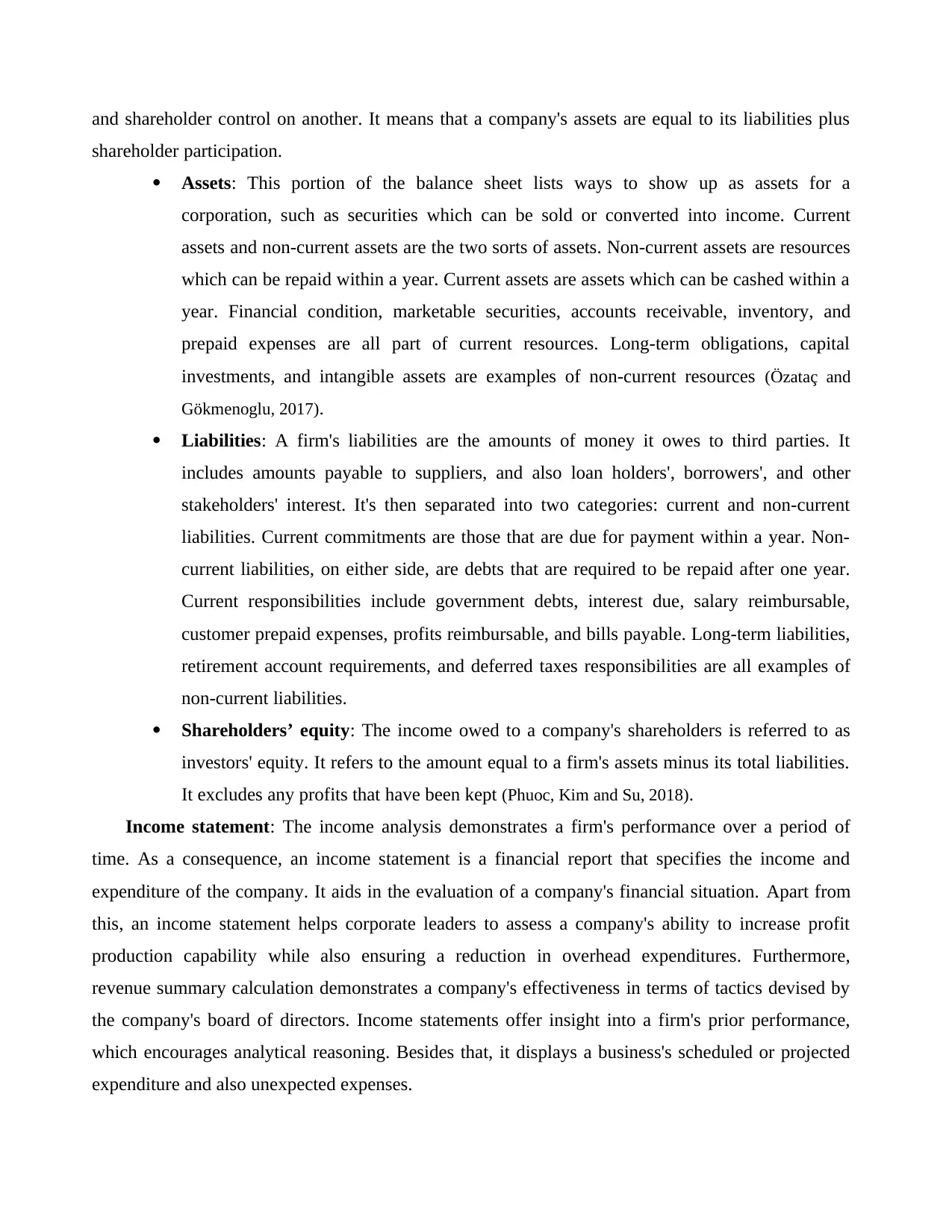
and shareholder control on another. It means that a company's assets are equal to its liabilities plus
shareholder participation.
Assets: This portion of the balance sheet lists ways to show up as assets for a
corporation, such as securities which can be sold or converted into income. Current
assets and non-current assets are the two sorts of assets. Non-current assets are resources
which can be repaid within a year. Current assets are assets which can be cashed within a
year. Financial condition, marketable securities, accounts receivable, inventory, and
prepaid expenses are all part of current resources. Long-term obligations, capital
investments, and intangible assets are examples of non-current resources (Özataç and
Gökmenoglu, 2017).
Liabilities: A firm's liabilities are the amounts of money it owes to third parties. It
includes amounts payable to suppliers, and also loan holders', borrowers', and other
stakeholders' interest. It's then separated into two categories: current and non-current
liabilities. Current commitments are those that are due for payment within a year. Non-
current liabilities, on either side, are debts that are required to be repaid after one year.
Current responsibilities include government debts, interest due, salary reimbursable,
customer prepaid expenses, profits reimbursable, and bills payable. Long-term liabilities,
retirement account requirements, and deferred taxes responsibilities are all examples of
non-current liabilities.
Shareholders’ equity: The income owed to a company's shareholders is referred to as
investors' equity. It refers to the amount equal to a firm's assets minus its total liabilities.
It excludes any profits that have been kept (Phuoc, Kim and Su, 2018).
Income statement: The income analysis demonstrates a firm's performance over a period of
time. As a consequence, an income statement is a financial report that specifies the income and
expenditure of the company. It aids in the evaluation of a company's financial situation. Apart from
this, an income statement helps corporate leaders to assess a company's ability to increase profit
production capability while also ensuring a reduction in overhead expenditures. Furthermore,
revenue summary calculation demonstrates a company's effectiveness in terms of tactics devised by
the company's board of directors. Income statements offer insight into a firm's prior performance,
which encourages analytical reasoning. Besides that, it displays a business's scheduled or projected
expenditure and also unexpected expenses.
shareholder participation.
Assets: This portion of the balance sheet lists ways to show up as assets for a
corporation, such as securities which can be sold or converted into income. Current
assets and non-current assets are the two sorts of assets. Non-current assets are resources
which can be repaid within a year. Current assets are assets which can be cashed within a
year. Financial condition, marketable securities, accounts receivable, inventory, and
prepaid expenses are all part of current resources. Long-term obligations, capital
investments, and intangible assets are examples of non-current resources (Özataç and
Gökmenoglu, 2017).
Liabilities: A firm's liabilities are the amounts of money it owes to third parties. It
includes amounts payable to suppliers, and also loan holders', borrowers', and other
stakeholders' interest. It's then separated into two categories: current and non-current
liabilities. Current commitments are those that are due for payment within a year. Non-
current liabilities, on either side, are debts that are required to be repaid after one year.
Current responsibilities include government debts, interest due, salary reimbursable,
customer prepaid expenses, profits reimbursable, and bills payable. Long-term liabilities,
retirement account requirements, and deferred taxes responsibilities are all examples of
non-current liabilities.
Shareholders’ equity: The income owed to a company's shareholders is referred to as
investors' equity. It refers to the amount equal to a firm's assets minus its total liabilities.
It excludes any profits that have been kept (Phuoc, Kim and Su, 2018).
Income statement: The income analysis demonstrates a firm's performance over a period of
time. As a consequence, an income statement is a financial report that specifies the income and
expenditure of the company. It aids in the evaluation of a company's financial situation. Apart from
this, an income statement helps corporate leaders to assess a company's ability to increase profit
production capability while also ensuring a reduction in overhead expenditures. Furthermore,
revenue summary calculation demonstrates a company's effectiveness in terms of tactics devised by
the company's board of directors. Income statements offer insight into a firm's prior performance,
which encourages analytical reasoning. Besides that, it displays a business's scheduled or projected
expenditure and also unexpected expenses.
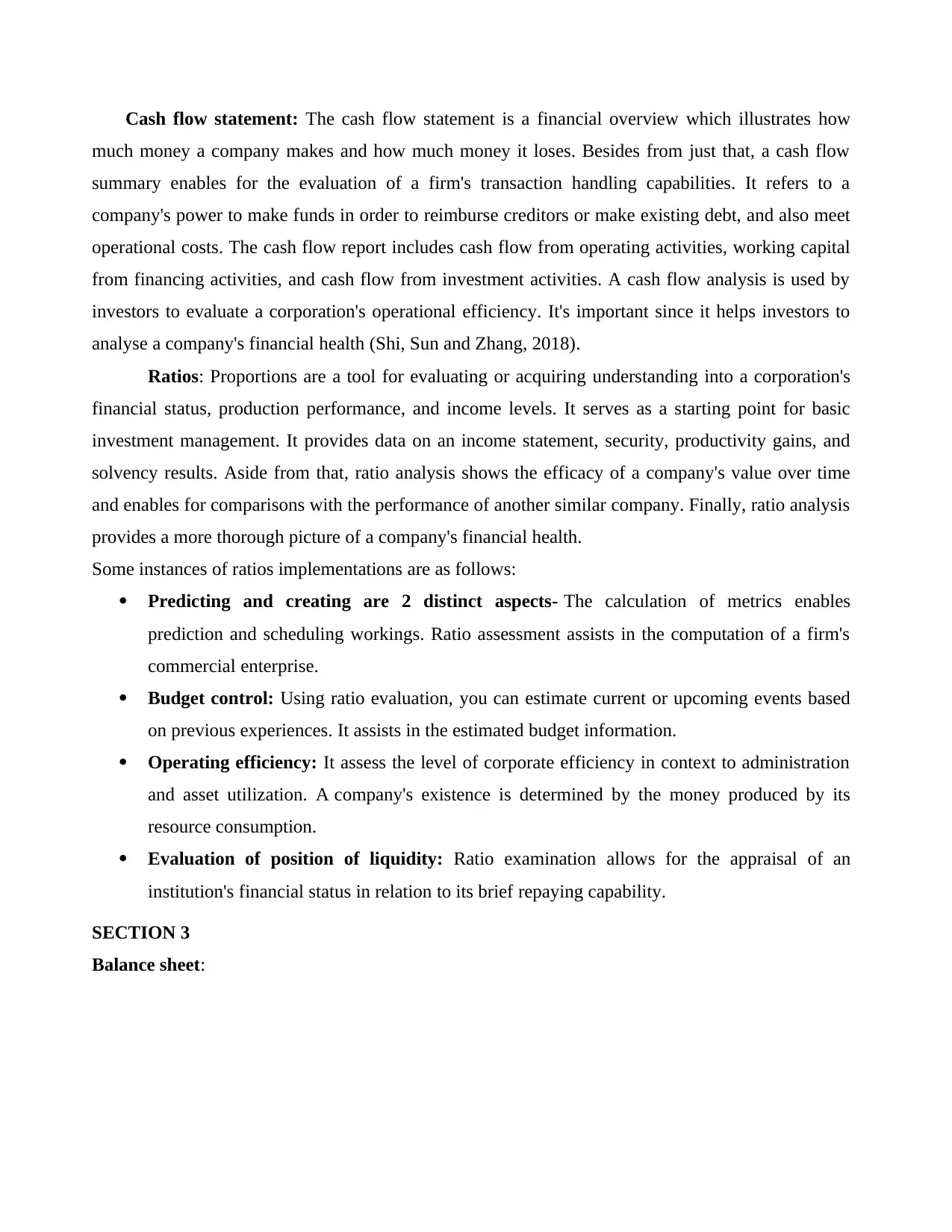
Cash flow statement: The cash flow statement is a financial overview which illustrates how
much money a company makes and how much money it loses. Besides from just that, a cash flow
summary enables for the evaluation of a firm's transaction handling capabilities. It refers to a
company's power to make funds in order to reimburse creditors or make existing debt, and also meet
operational costs. The cash flow report includes cash flow from operating activities, working capital
from financing activities, and cash flow from investment activities. A cash flow analysis is used by
investors to evaluate a corporation's operational efficiency. It's important since it helps investors to
analyse a company's financial health (Shi, Sun and Zhang, 2018).
Ratios: Proportions are a tool for evaluating or acquiring understanding into a corporation's
financial status, production performance, and income levels. It serves as a starting point for basic
investment management. It provides data on an income statement, security, productivity gains, and
solvency results. Aside from that, ratio analysis shows the efficacy of a company's value over time
and enables for comparisons with the performance of another similar company. Finally, ratio analysis
provides a more thorough picture of a company's financial health.
Some instances of ratios implementations are as follows:
Predicting and creating are 2 distinct aspects- The calculation of metrics enables
prediction and scheduling workings. Ratio assessment assists in the computation of a firm's
commercial enterprise.
Budget control: Using ratio evaluation, you can estimate current or upcoming events based
on previous experiences. It assists in the estimated budget information.
Operating efficiency: It assess the level of corporate efficiency in context to administration
and asset utilization. A company's existence is determined by the money produced by its
resource consumption.
Evaluation of position of liquidity: Ratio examination allows for the appraisal of an
institution's financial status in relation to its brief repaying capability.
SECTION 3
Balance sheet:
much money a company makes and how much money it loses. Besides from just that, a cash flow
summary enables for the evaluation of a firm's transaction handling capabilities. It refers to a
company's power to make funds in order to reimburse creditors or make existing debt, and also meet
operational costs. The cash flow report includes cash flow from operating activities, working capital
from financing activities, and cash flow from investment activities. A cash flow analysis is used by
investors to evaluate a corporation's operational efficiency. It's important since it helps investors to
analyse a company's financial health (Shi, Sun and Zhang, 2018).
Ratios: Proportions are a tool for evaluating or acquiring understanding into a corporation's
financial status, production performance, and income levels. It serves as a starting point for basic
investment management. It provides data on an income statement, security, productivity gains, and
solvency results. Aside from that, ratio analysis shows the efficacy of a company's value over time
and enables for comparisons with the performance of another similar company. Finally, ratio analysis
provides a more thorough picture of a company's financial health.
Some instances of ratios implementations are as follows:
Predicting and creating are 2 distinct aspects- The calculation of metrics enables
prediction and scheduling workings. Ratio assessment assists in the computation of a firm's
commercial enterprise.
Budget control: Using ratio evaluation, you can estimate current or upcoming events based
on previous experiences. It assists in the estimated budget information.
Operating efficiency: It assess the level of corporate efficiency in context to administration
and asset utilization. A company's existence is determined by the money produced by its
resource consumption.
Evaluation of position of liquidity: Ratio examination allows for the appraisal of an
institution's financial status in relation to its brief repaying capability.
SECTION 3
Balance sheet:
⊘ This is a preview!⊘
Do you want full access?
Subscribe today to unlock all pages.

Trusted by 1+ million students worldwide
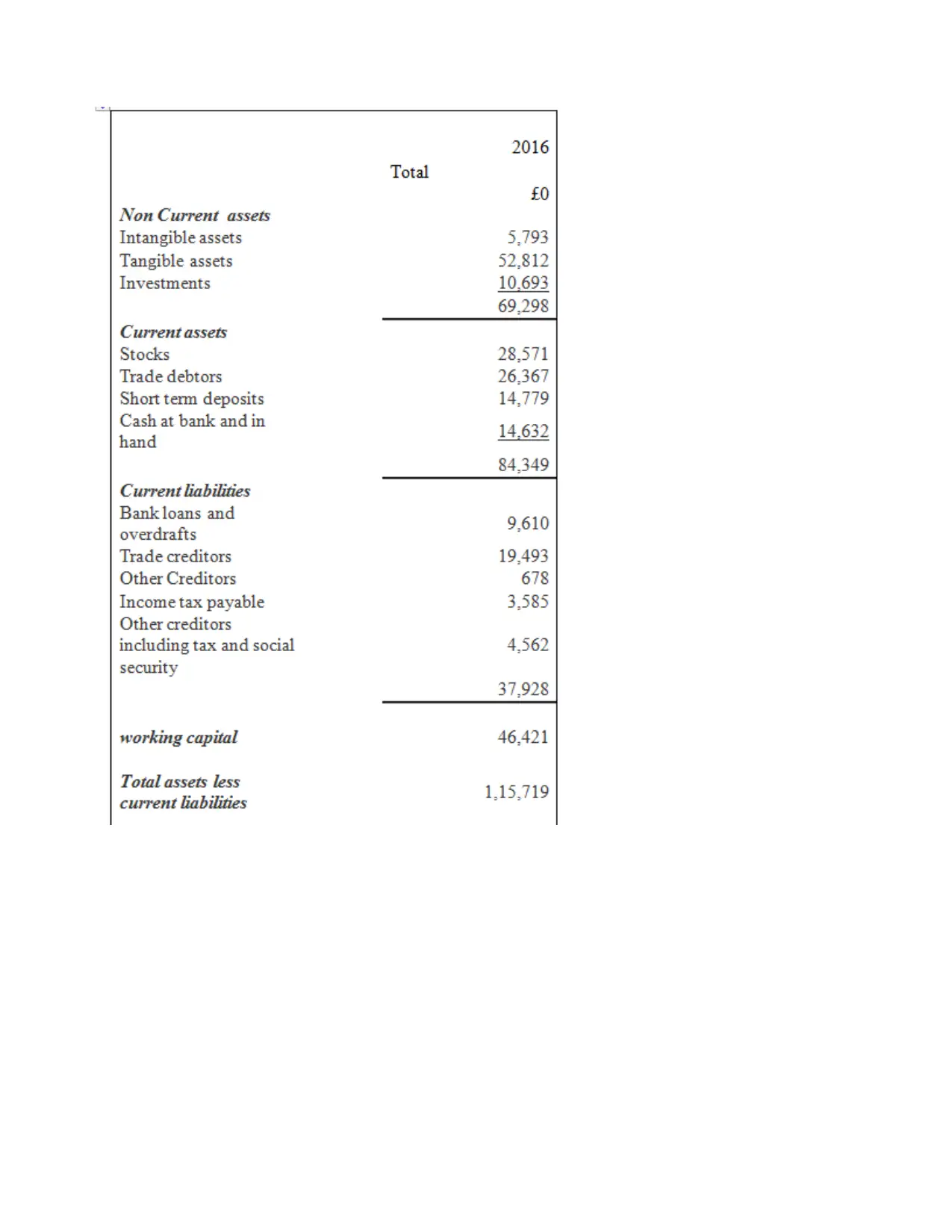
Paraphrase This Document
Need a fresh take? Get an instant paraphrase of this document with our AI Paraphraser
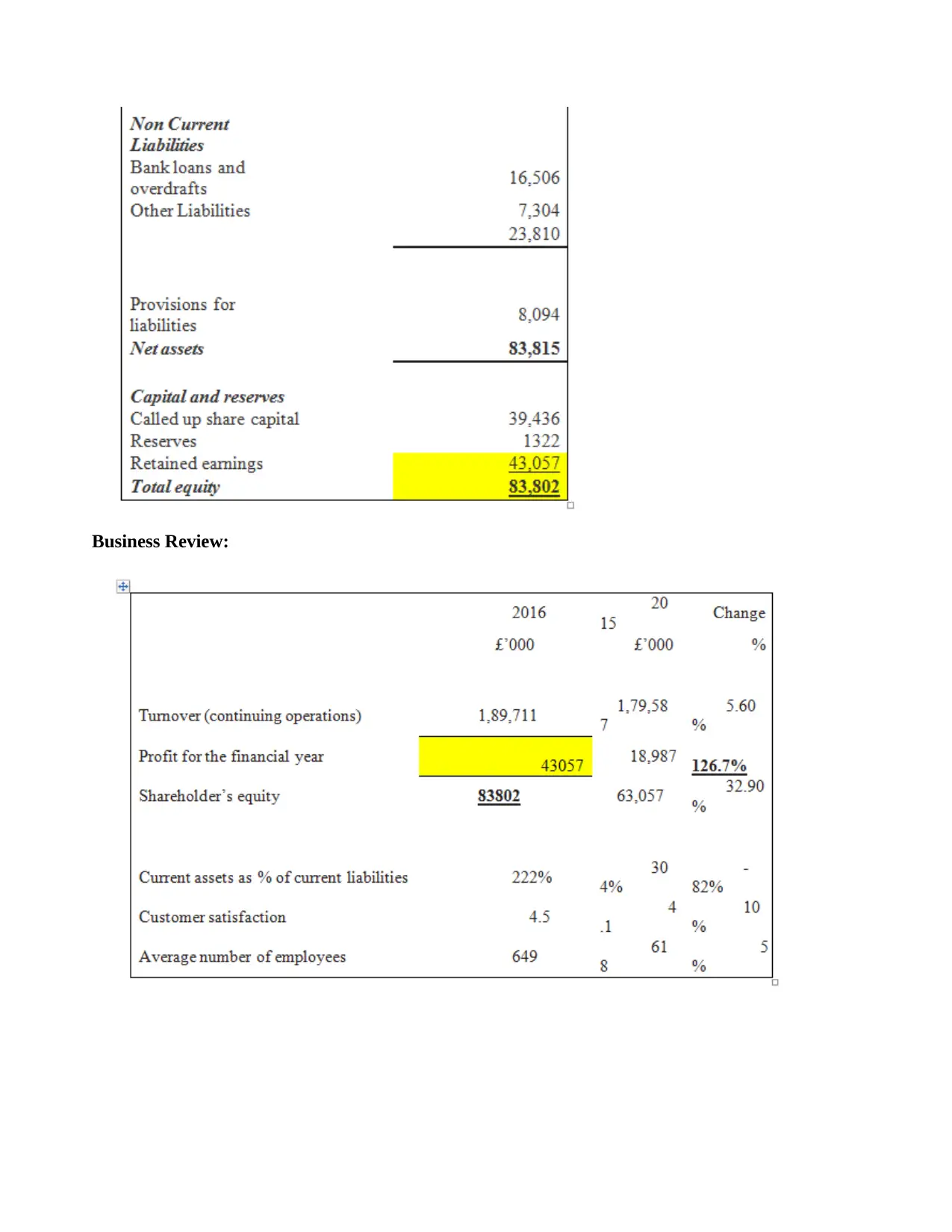
Business Review:
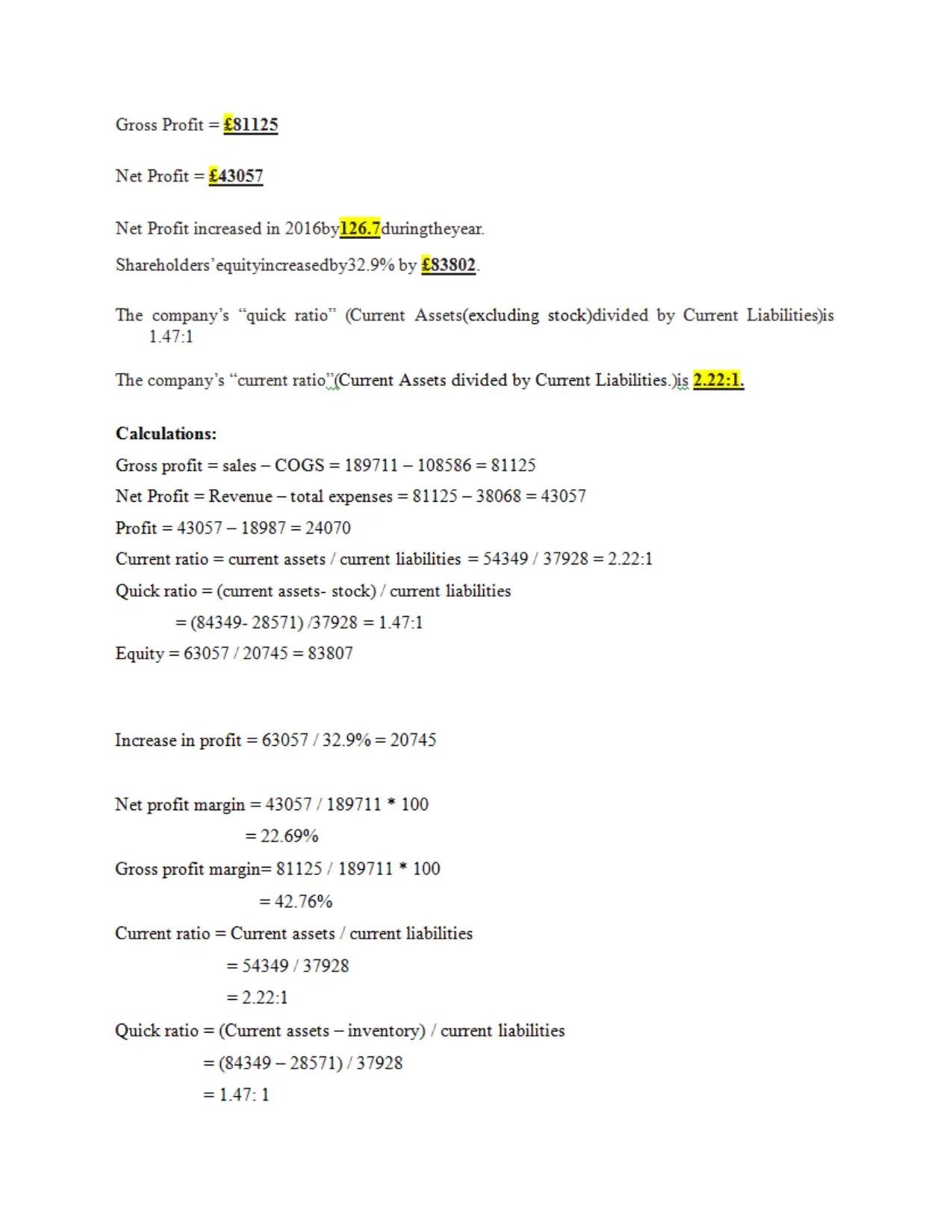
⊘ This is a preview!⊘
Do you want full access?
Subscribe today to unlock all pages.

Trusted by 1+ million students worldwide
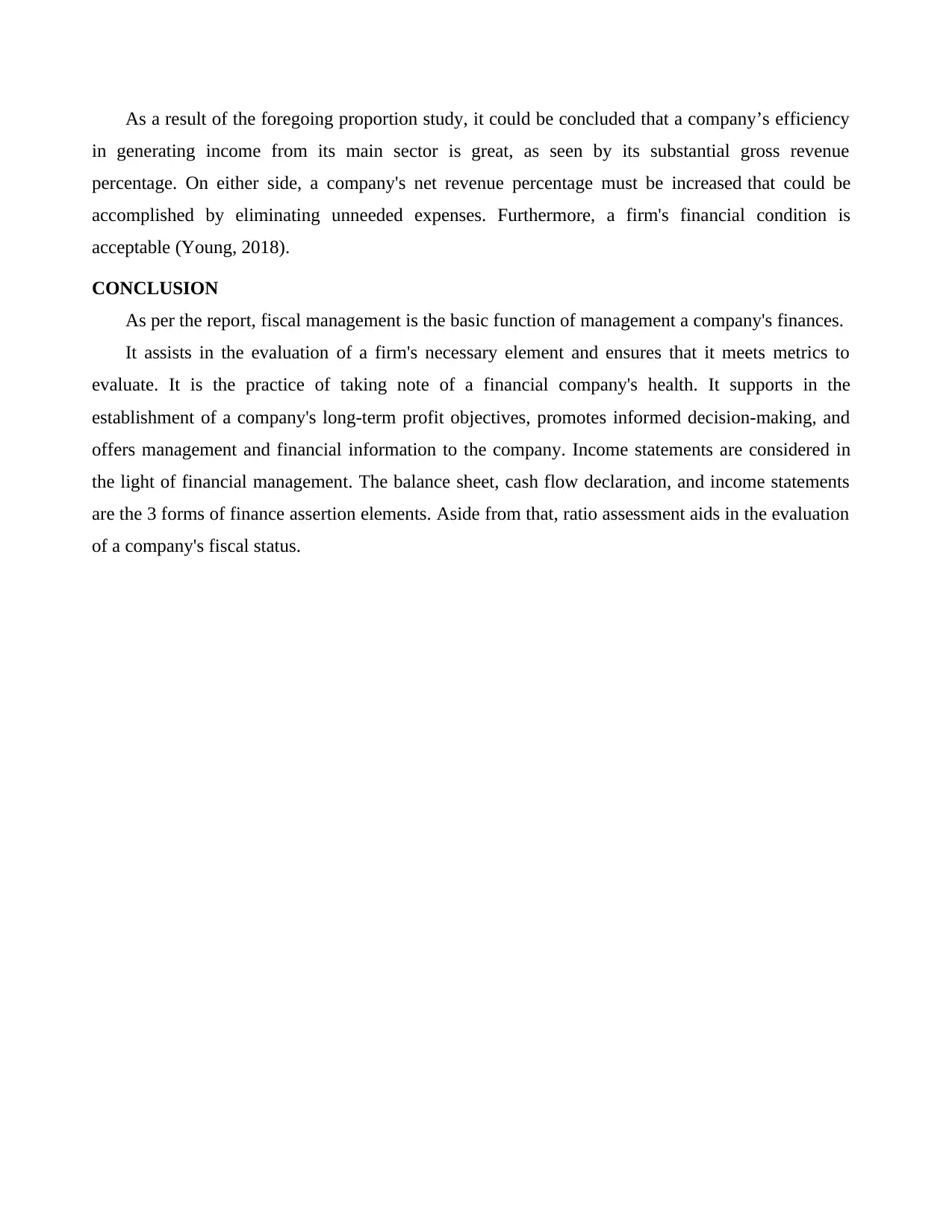
As a result of the foregoing proportion study, it could be concluded that a company’s efficiency
in generating income from its main sector is great, as seen by its substantial gross revenue
percentage. On either side, a company's net revenue percentage must be increased that could be
accomplished by eliminating unneeded expenses. Furthermore, a firm's financial condition is
acceptable (Young, 2018).
CONCLUSION
As per the report, fiscal management is the basic function of management a company's finances.
It assists in the evaluation of a firm's necessary element and ensures that it meets metrics to
evaluate. It is the practice of taking note of a financial company's health. It supports in the
establishment of a company's long-term profit objectives, promotes informed decision-making, and
offers management and financial information to the company. Income statements are considered in
the light of financial management. The balance sheet, cash flow declaration, and income statements
are the 3 forms of finance assertion elements. Aside from that, ratio assessment aids in the evaluation
of a company's fiscal status.
in generating income from its main sector is great, as seen by its substantial gross revenue
percentage. On either side, a company's net revenue percentage must be increased that could be
accomplished by eliminating unneeded expenses. Furthermore, a firm's financial condition is
acceptable (Young, 2018).
CONCLUSION
As per the report, fiscal management is the basic function of management a company's finances.
It assists in the evaluation of a firm's necessary element and ensures that it meets metrics to
evaluate. It is the practice of taking note of a financial company's health. It supports in the
establishment of a company's long-term profit objectives, promotes informed decision-making, and
offers management and financial information to the company. Income statements are considered in
the light of financial management. The balance sheet, cash flow declaration, and income statements
are the 3 forms of finance assertion elements. Aside from that, ratio assessment aids in the evaluation
of a company's fiscal status.
Paraphrase This Document
Need a fresh take? Get an instant paraphrase of this document with our AI Paraphraser
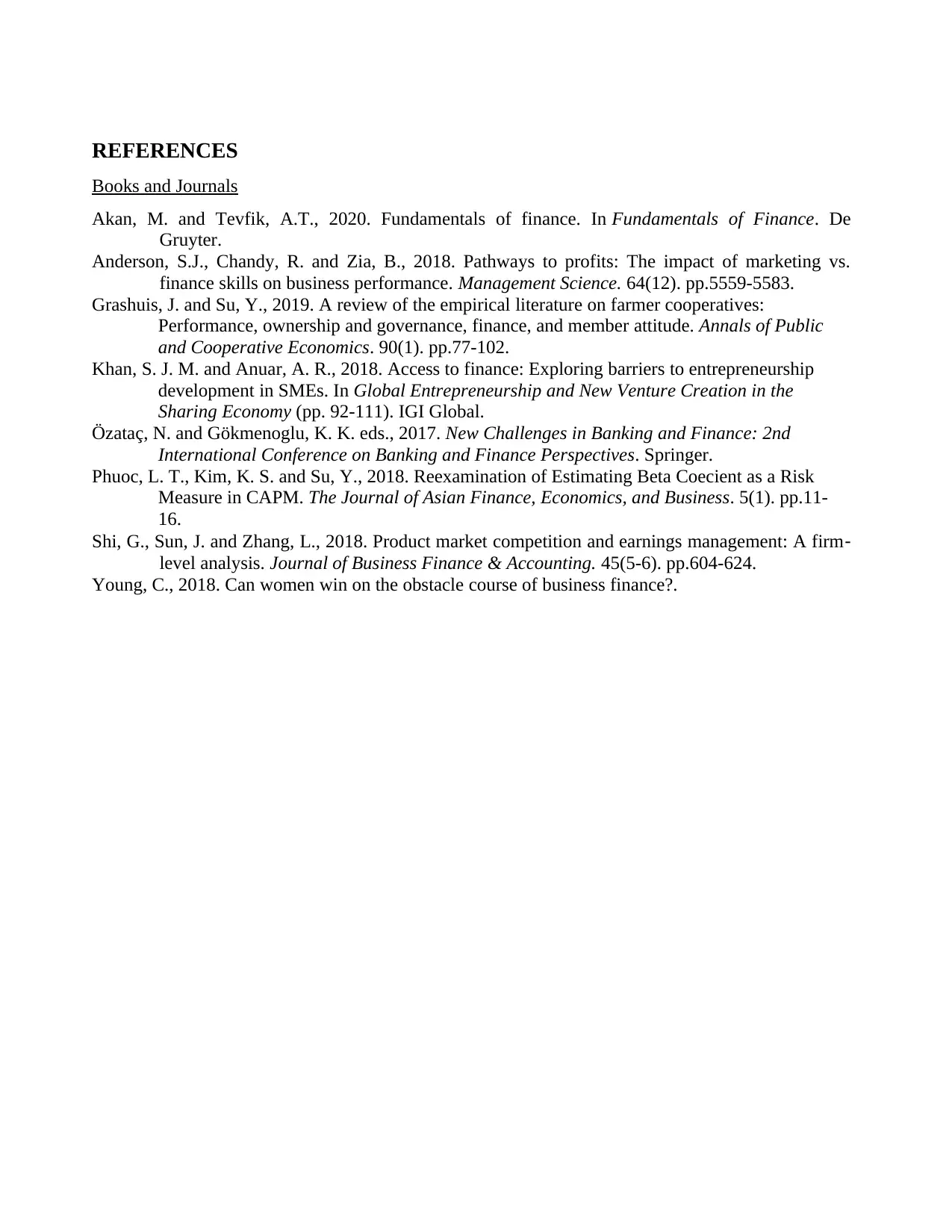
REFERENCES
Books and Journals
Akan, M. and Tevfik, A.T., 2020. Fundamentals of finance. In Fundamentals of Finance. De
Gruyter.
Anderson, S.J., Chandy, R. and Zia, B., 2018. Pathways to profits: The impact of marketing vs.
finance skills on business performance. Management Science. 64(12). pp.5559-5583.
Grashuis, J. and Su, Y., 2019. A review of the empirical literature on farmer cooperatives:
Performance, ownership and governance, finance, and member attitude. Annals of Public
and Cooperative Economics. 90(1). pp.77-102.
Khan, S. J. M. and Anuar, A. R., 2018. Access to finance: Exploring barriers to entrepreneurship
development in SMEs. In Global Entrepreneurship and New Venture Creation in the
Sharing Economy (pp. 92-111). IGI Global.
Özataç, N. and Gökmenoglu, K. K. eds., 2017. New Challenges in Banking and Finance: 2nd
International Conference on Banking and Finance Perspectives. Springer.
Phuoc, L. T., Kim, K. S. and Su, Y., 2018. Reexamination of Estimating Beta Coecient as a Risk
Measure in CAPM. The Journal of Asian Finance, Economics, and Business. 5(1). pp.11-
16.
Shi, G., Sun, J. and Zhang, L., 2018. Product market competition and earnings management: A firm‐
level analysis. Journal of Business Finance & Accounting. 45(5-6). pp.604-624.
Young, C., 2018. Can women win on the obstacle course of business finance?.
Books and Journals
Akan, M. and Tevfik, A.T., 2020. Fundamentals of finance. In Fundamentals of Finance. De
Gruyter.
Anderson, S.J., Chandy, R. and Zia, B., 2018. Pathways to profits: The impact of marketing vs.
finance skills on business performance. Management Science. 64(12). pp.5559-5583.
Grashuis, J. and Su, Y., 2019. A review of the empirical literature on farmer cooperatives:
Performance, ownership and governance, finance, and member attitude. Annals of Public
and Cooperative Economics. 90(1). pp.77-102.
Khan, S. J. M. and Anuar, A. R., 2018. Access to finance: Exploring barriers to entrepreneurship
development in SMEs. In Global Entrepreneurship and New Venture Creation in the
Sharing Economy (pp. 92-111). IGI Global.
Özataç, N. and Gökmenoglu, K. K. eds., 2017. New Challenges in Banking and Finance: 2nd
International Conference on Banking and Finance Perspectives. Springer.
Phuoc, L. T., Kim, K. S. and Su, Y., 2018. Reexamination of Estimating Beta Coecient as a Risk
Measure in CAPM. The Journal of Asian Finance, Economics, and Business. 5(1). pp.11-
16.
Shi, G., Sun, J. and Zhang, L., 2018. Product market competition and earnings management: A firm‐
level analysis. Journal of Business Finance & Accounting. 45(5-6). pp.604-624.
Young, C., 2018. Can women win on the obstacle course of business finance?.
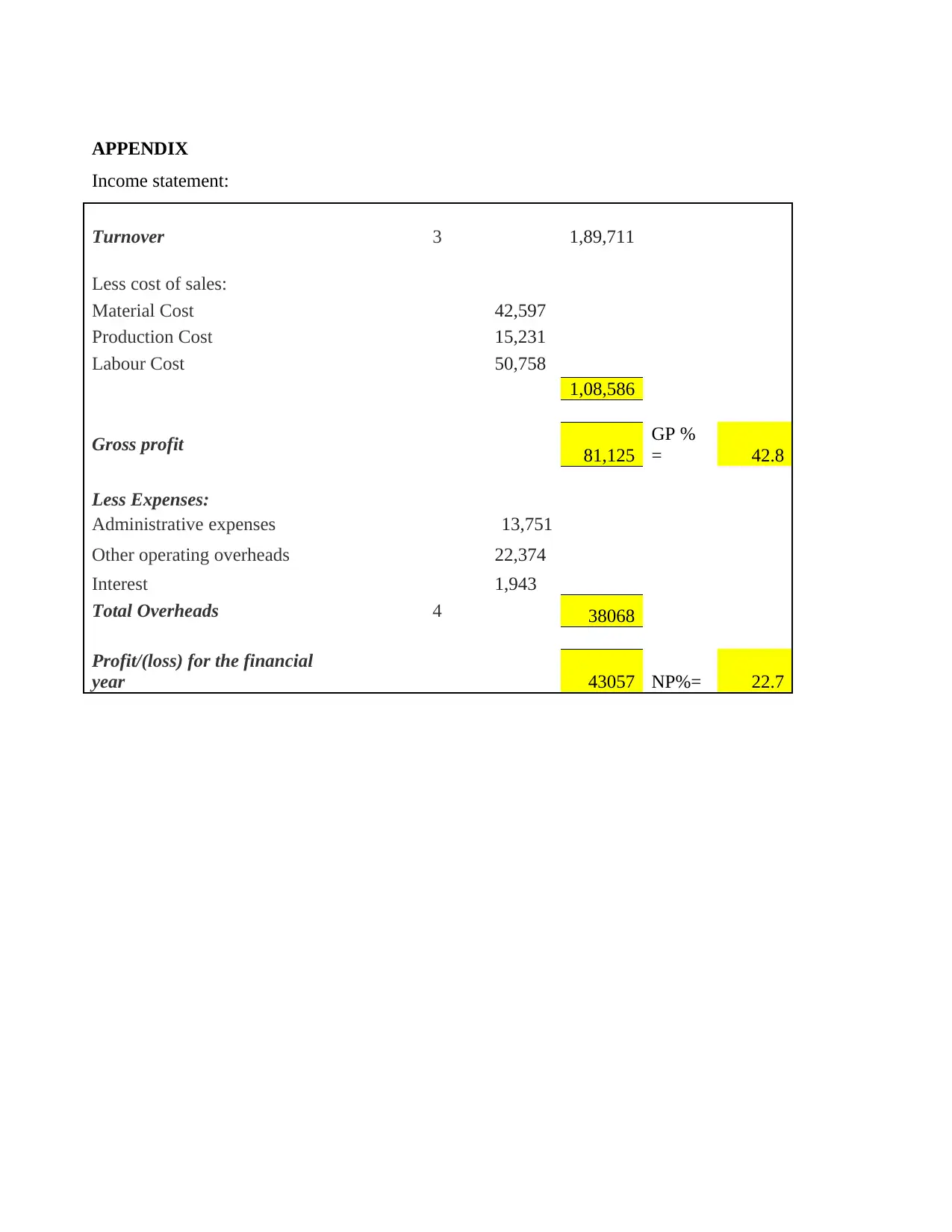
APPENDIX
Income statement:
Turnover 3 1,89,711
Less cost of sales:
Material Cost 42,597
Production Cost 15,231
Labour Cost 50,758
1,08,586
Gross profit 81,125
GP %
= 42.8
Less Expenses:
Administrative expenses 13,751
Other operating overheads 22,374
Interest 1,943
Total Overheads 4 38068
Profit/(loss) for the financial
year 43057 NP%= 22.7
Income statement:
Turnover 3 1,89,711
Less cost of sales:
Material Cost 42,597
Production Cost 15,231
Labour Cost 50,758
1,08,586
Gross profit 81,125
GP %
= 42.8
Less Expenses:
Administrative expenses 13,751
Other operating overheads 22,374
Interest 1,943
Total Overheads 4 38068
Profit/(loss) for the financial
year 43057 NP%= 22.7
⊘ This is a preview!⊘
Do you want full access?
Subscribe today to unlock all pages.

Trusted by 1+ million students worldwide
1 out of 12
Related Documents
Your All-in-One AI-Powered Toolkit for Academic Success.
+13062052269
info@desklib.com
Available 24*7 on WhatsApp / Email
![[object Object]](/_next/static/media/star-bottom.7253800d.svg)
Unlock your academic potential
Copyright © 2020–2025 A2Z Services. All Rights Reserved. Developed and managed by ZUCOL.





